将 5G 物理信道和信号映射到资源网格
此示例展示了如何使用 5G Toolbox™ 功能生成 5G NR (New Radio) 物理信道和信号并将其映射到资源网格。
简介
下图显示了此示例中在 5G 下行链路的环境下建模的链路元素。这些元素是:
物理下行链路共享信道 (PDSCH) 及其解调参考信号 (DM-RS) 的生成
MIMO 预编码与 PDSCH 和 PDSCH DM-RS 到资源网格的映射
OFDM 调制

载波配置
指定发射天线的数量并创建一个载波配置对象。此对象控制资源网格的大小。为简单起见,请使用默认的载波配置对象。
nTxAnts = 4; carrier = nrCarrierConfig
carrier =
nrCarrierConfig with properties:
NCellID: 1
SubcarrierSpacing: 15
CyclicPrefix: 'normal'
NSizeGrid: 52
NStartGrid: 0
NSlot: 0
NFrame: 0
IntraCellGuardBands: [0×2 double]
Read-only properties:
SymbolsPerSlot: 14
SlotsPerSubframe: 1
SlotsPerFrame: 10
PDSCH 和 PDSCH DM-RS 的配置
创建一个 PDSCH 配置对象。此对象指定 PDSCH 相关参数。请指定 16-QAM 调制、两层和全频段分配。此配置将 PDSCH 映射到与载波大小相等的带宽部分 (BWP)。您还可以使用此对象指定其他时间分配参数和 DM-RS 设置。
pdsch = nrPDSCHConfig; pdsch.Modulation = "16QAM"; pdsch.NumLayers = 2; pdsch.PRBSet = 0:carrier.NSizeGrid-1; % Full band allocation
显示 PDSCH 和 PDSCH DM-RS 参数。
pdsch
pdsch =
nrPDSCHConfig with properties:
NSizeBWP: []
NStartBWP: []
ReservedPRB: {[1×1 nrPDSCHReservedConfig]}
ReservedRE: []
Modulation: '16QAM'
NumLayers: 2
MappingType: 'A'
SymbolAllocation: [0 14]
PRBSet: [0 1 2 3 4 5 6 7 8 9 10 11 12 13 14 15 16 17 18 19 20 21 22 23 24 25 26 27 28 29 30 31 32 33 34 35 36 37 38 39 40 41 42 43 44 45 46 47 48 49 50 51]
PRBSetType: 'VRB'
VRBToPRBInterleaving: 0
VRBBundleSize: 2
NID: []
RNTI: 1
DMRS: [1×1 nrPDSCHDMRSConfig]
EnablePTRS: 0
PTRS: [1×1 nrPDSCHPTRSConfig]
Read-only properties:
NumCodewords: 1
pdsch.DMRS
ans =
nrPDSCHDMRSConfig with properties:
DMRSConfigurationType: 1
DMRSReferencePoint: 'CRB0'
DMRSTypeAPosition: 2
DMRSAdditionalPosition: 0
DMRSLength: 1
CustomSymbolSet: []
DMRSPortSet: []
NIDNSCID: []
NSCID: 0
NumCDMGroupsWithoutData: 2
DMRSDownlinkR16: 0
DMRSEnhancedR18: 0
Read-only properties:
CDMGroups: [0 0]
DeltaShifts: [0 0]
FrequencyWeights: [2×2 double]
TimeWeights: [2×2 double]
DMRSSubcarrierLocations: [6×2 double]
CDMLengths: [2 1]
PDSCH 的生成
生成索引以将 PDSCH 映射到网格。
[pdschIndices,pdschInfo] = nrPDSCHIndices(carrier,pdsch);
生成随机 PDSCH 比特并将其映射到 PDSCH 符号。输入参量 pdschInfo.G 指定 PDSCH 的比特容量,这是信道编码阶段中码字的长度。pdschInfo.G 将可用于 PDSCH 发送的资源元素 (RE) 考虑在内。为简单起见,此示例未包括下行链路共享信道 (DL-SCH) 建模。
pdschBits = randi([0 1],pdschInfo.G,1);
生成 PDSCH 符号。PDSCH 符号存储在大小为 × 的矩阵中,其中 是符号数, 是层数。
pdschSymbols = nrPDSCH(carrier,pdsch,pdschBits); size(pdschSymbols)
ans = 1×2
8112 2
PDSCH DM-RS 的生成
生成 DM-RS 符号和索引。
dmrsSymbols = nrPDSCHDMRS(carrier,pdsch); dmrsIndices = nrPDSCHDMRSIndices(carrier,pdsch);
显示带有 PDSCH 和 PDSCH DM-RS 符号的星座图。
plot(pdschSymbols(:),"o");hold on plot(dmrsSymbols(:),"xr");hold off title("PDSCH and PDSCH DM-RS Symbols");xlabel("In-Phase Amplitude");ylabel("Quadrature Amplitude") legend("PDSCH","PDSCH DM-RS")
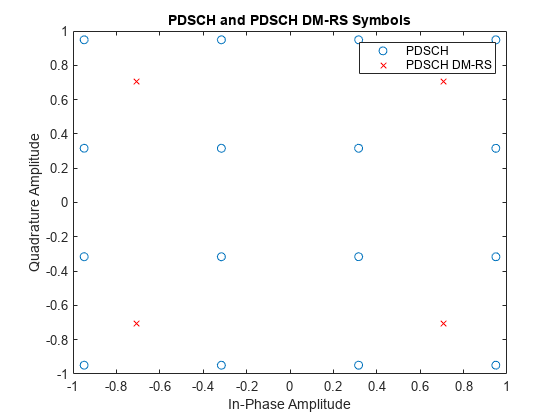
MIMO 的预编码与到资源网格的映射
应用预编码。信道测量值用于确定预编码权重(也称为波束成形权重)。不过,此示例没有对传播信道进行建模。此示例假设预编码权重是已知的。
% Precoding weights W = fft(eye(nTxAnts))/sqrt(nTxAnts); % Unitary precoding matrix w = W(1:pdsch.NumLayers,:)/sqrt(pdsch.NumLayers); % Normalize by number of layers
预编码矩阵 w 必须是大小为 × 的矩阵,其中 是层数, 是发射天线的数量。
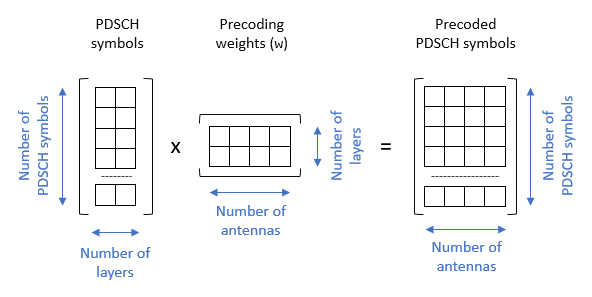
size(pdschSymbols)
ans = 1×2
8112 2
size(w)
ans = 1×2
2 4
对 PDSCH 符号进行预编码。
pdschSymbolsPrecoded = pdschSymbols*w;
pdschSymbolsPrecoded 矩阵的行数对应于 PDSCH 符号的数量,而列数对应于天线的数量。
size(pdschSymbolsPrecoded)
ans = 1×2
8112 4
生成一个空的资源网格。此网格跨一个时隙。
pdschGrid = nrResourceGrid(carrier,nTxAnts);
将 PDSCH 符号映射到资源网格时,请注意 nrPDSCHIndices 函数生成的 PDSCH 索引指的是层而不是天线。当您将 PDSCH 符号直接映射到层时,此格式可能非常有用。在这种情况下,生成的资源网格没有进行预编码。
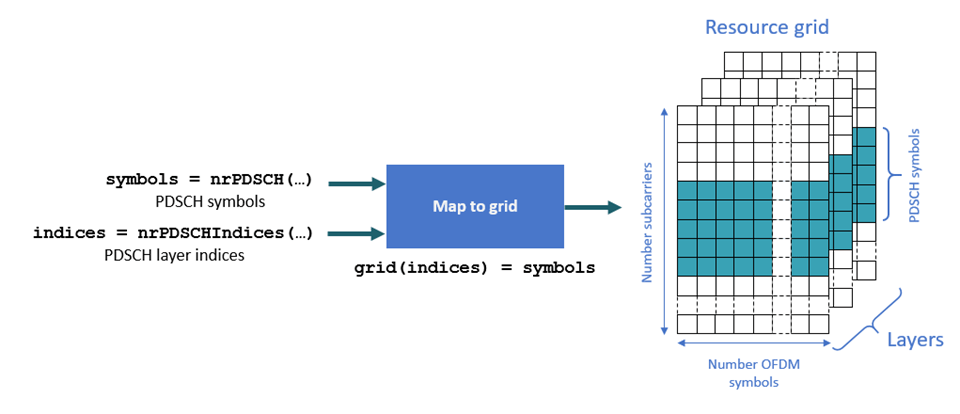
因为此示例在将 PDSCH 符号映射到资源网格之前对这些符号应用预编码,所以经预编码的 PDSCH 符号映射到天线而不是层。要将层索引转换为天线索引,请使用 nrExtractResources 函数。
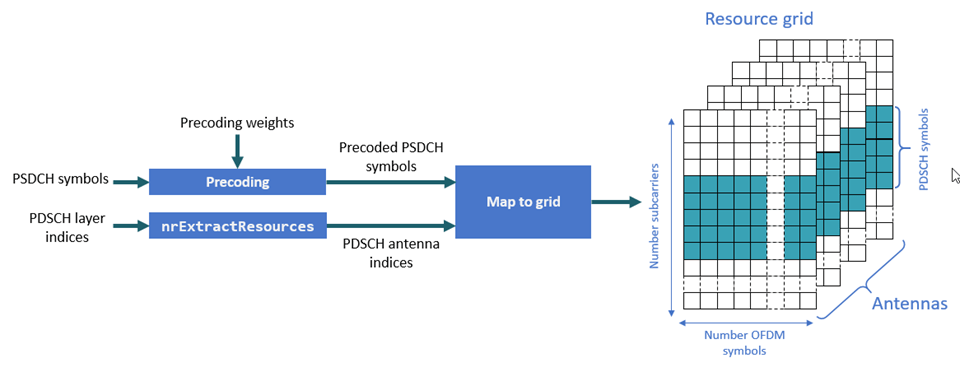
[~,pdschAntIndices] = nrExtractResources(pdschIndices,pdschGrid); pdschGrid(pdschAntIndices) = pdschSymbolsPrecoded;
显示第一个天线的资源网格。蓝色间隙是留给 DM-RS 的。
imagesc([0 carrier.SymbolsPerSlot-1],[0 carrier.NSizeGrid*12-1],abs(pdschGrid(:,:,1))); axis xy;title("Resource Grid (First Antenna) - PDSCH");xlabel("OFDM Symbol");ylabel("Subcarrier")

对 DM-RS 符号进行预编码并将其映射到网格。与 PDSCH 索引类似,DM-RS 索引指的是层。要将这些层转换为多天线索引,请再次使用 nrExtractResources 函数。
% PDSCH DM-RS precoding and mapping for p = 1:size(dmrsSymbols,2) [~,dmrsAntIndices] = nrExtractResources(dmrsIndices(:,p),pdschGrid); pdschGrid(dmrsAntIndices) = pdschGrid(dmrsAntIndices) + dmrsSymbols(:,p)*w(p,:); end
显示第一个天线的资源网格。
imagesc([0 carrier.SymbolsPerSlot-1],[0 carrier.NSizeGrid*12-1],abs(pdschGrid(:,:,1))); axis xy;title("Resource Grid (First Antenna) - PDSCH and PDSCH DM-RS"); xlabel("OFDM Symbol");ylabel("Subcarrier")
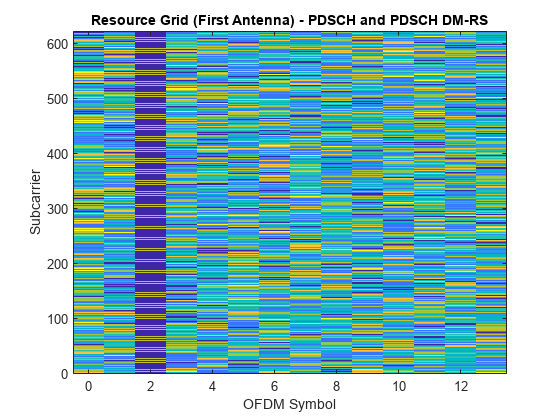
在资源网格中显示单个资源块 (RB)。此视图可放大到单个 RB,并提供 RE 内容的详细视图。
imagesc(abs(pdschGrid(1:12,:,1)));view(2) axis xy;title("Resource Block - PDSCH and PDSCH DM-RS");ylabel("Subcarrier");xlabel("OFDM Symbol")

OFDM 调制
对资源网格进行 OFDM 调制并显示第一个天线的时域波形。
[txWaveform,waveformInfo] = nrOFDMModulate(carrier,pdschGrid); plot(abs(txWaveform(:,1)));title("Time Domain Waveform (First Antenna)");xlabel("Sample Number");ylabel("Magnitude")

waveformInfo 输出包含有关时域波形的信息,例如采样率。
waveformInfo
waveformInfo = struct with fields:
Nfft: 1024
SampleRate: 15360000
CyclicPrefixLengths: [80 72 72 72 72 72 72 80 72 72 72 72 72 72]
SymbolLengths: [1104 1096 1096 1096 1096 1096 1096 1104 1096 1096 1096 1096 1096 1096]
Windowing: 36
SymbolPhases: [0 0 0 0 0 0 0 0 0 0 0 0 0 0]
SymbolsPerSlot: 14
SlotsPerSubframe: 1
SlotsPerFrame: 10